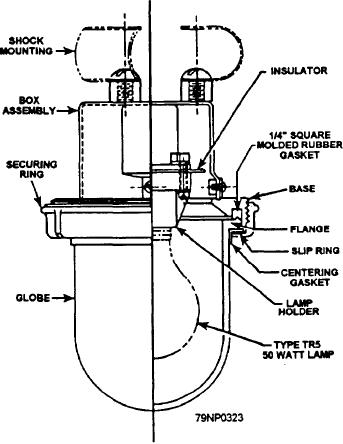
regular intervals to prevent a waste of energy and low
Regular red- or yellow-light fixtures (incandescent
intensity illumination.
or fluorescent) are permanently installed to provide
low-level, red or yellow illumination in berthing areas,
The loss of light caused by the accumulation of dirt,
in access routes to topside battle and watch stations, and
dust, and film on the lamps and fixtures greatly reduces
in special compartments and stations. The incandescent
the efficiency of a lighting system. The actual loss of
fixtures are equipped with steamtight, inside
light from this cause depends on the extent that oil
acid-etched, red or yellow globes.
fumes, dust, and dirt are present in the surrounding
atmosphere, and how often the fixtures are cleaned.
Portable fixtures (incandescent and fluorescent) are
provided for lighting applications for which the need is
When a fixture requires cleaning, turn off the light
infrequent or cannot be served by permanent y installed
and remove the glassware from the lamp. Inspect
fixtures. These units are energized by means of portable
internal components, wiring, and lamp holders for
cables that are plugged into outlets in the ship's service
deterioration breaks, or cracks.
wiring system and include bedside lights, deck lights,
Replace them if necessary. Wash the glassware,
extension lights, and floodlights.
lamp, and reflector with soap and water. When washing
Weatherdeck lighting fixtures are provided to
aluminum reflectors, avoid the use of strong alkaline
illuminate topside areas for underway replenishment
and acid detergents. Rinse the washed parts with
and for flight deck operations. The fixtures are
clean, fresh water that contains a few drops of ammonia
watertight and are shown in figure 4-13. Previously, red
added to remove the soap film. Dry the parts with a soft
lighting was used for weatherdeck illumination
cloth and replace them in the fixture.
involving replenishment-at-sea stations, and white
To replace a burned-out lamp in a watertight fixture
lighting was used for special in applications such as
(fig. 4-14), unscrew the securing ring with a spanner
inport deck lights, carrier flightdeck lights, and salvage
wrench, remove the globe, and replace the burned-out
operation lights. A change was authorized by the Chief
lamp with a new one. Inspect the rubber gasket in the
of Naval Operations (CNO) to change all external
base and the centering gasket on the outside of the
lighting to yellow, with the exception of red navigation
and signal lights. This change consisted of replacing all
converters, lenses, sleeves, windows, and lamps from
red to yellow. The removed items must be retained on
board for wartime use.
Miscellaneous fixtures (incandescent or
fluorescent) are provided for detail and special lighting
applications that cannot be served by regular permanent
or regular portable lighting fixtures. These fixtures
include boom lights, crane lights, gangway lights,
portable flood lanterns, hand lanterns, and flashlights.
Navigation lights (incandescent) include all
external lights (running, signal, and anchor), except
searchlights, which are used for navigation and
signaling while underway or at anchor.
Lights for night-flight operations are used to assist
pilots (at night) when taking off and landing. These
lights also provide visual aid to pilots for locating and
identifying the parent ship.
MAINTENANCE OF FIXTURES
The lighting system should be maintained at its
maximum efficiency because artificial light has an
important bearing on the effectiveness of operation of a
Figure 4-14.--A symbol 92.2 watertight fixture.
naval ship. All lighting fixtures should be cleaned at
4-15

